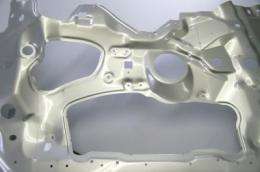Resource-friendly car manufacturing

Magnesium instead of steel -- this could be an option for lightweight car body parts. A car door made of magnesium is roughly 50 percent lighter. This is one of the exhibits drawn from along the automobile manufacturing chain that researchers at the Fraunhofer AutoMOBILE Production Alliance are showcasing at the Hannover Messe, April 4-8.
Lighter, more economical, more reasonably priced – that is the motto. If possible, equipped with electric drive, too. Carmakers have lots of demands to meet. Researchers at the Fraunhofer AutoMOBILE Production Alliance help carmakers meet these demands, and the developments they are working on include lightweight car components. They are presenting the results of their work at the Hannover Messe in the form of a "glass car."
A car door made of magnesium
One example is the car door made of magnesium, a development by researchers at the die Fraunhofer Institute for Machine Tools and Forming Technology IWU in Chemnitz. The door weighs just around 4.7 kilograms (a little over 10 pounds). By way of comparison: the version in steel weighs some 10.7 kilos (about 23.5 lbs). Of all substances, though, why magnesium? "Magnesium is available in large quantities worldwide, it can be molded, and for similar structures – a car door, for instance – it has virtually the same properties as steel. "For example, it has a comparable rigidity" summarizes Sören Scheffler, group manager at IWU. "We have developed specific molding technologies for wrought magnesium alloys. This makes the lightweight material available for future use in series production of car bodies."
How can the quantities of materials used be reduced? What recyclable materials offer a long-term supply and are candidates for reduction? And what resource-saving technologies and plant technologies offer adequate potential for the future? In all, the researchers will be showcasing around 40 new developments – and thus an excerpt of the entire production chain, from the planning stages to the complete and painted vehicle. "Our displays focus on the themes of a car's body, powertrain, interior, vehicle assembly, methodological competence and production research for electromobility," explains Alliance coordinator Lars Koch.
Slide-ground tumbled alloy wheel rims
The researchers will be presenting a slide-ground tumbled alloy wheel rim, for instance. In the process of slide-grinding and tumbling, the wheel rim is moved through a fill of abrasive media moving with a particular frequency. As one would with sand paper, manufacturers begin with coarse abrasive media and replace this with finer and finer abrasives over several steps. While slide-grinding is a conventional technology, to date it has lacked clear specifications: what frequency must be used to stimulate the abrasive media? How does one move the wheel rim through the process? What geometries and shapes of abrasive media are best suited to the task? Researchers at the Fraunhofer Institute for Production Systems and Design Technology IPK in Berlin are now investigating the theoretical connections and making a systematic record of them.
New adhesive technologies
Car manufacturing can also be optimized through the use of new joining processes. Researchers at the Fraunhofer Institute for Manufacturing Technology and Advanced Research IFAM in Bremen have come up with a gluing process that allows for markedly faster production, such as in the glass front of a headlight. Conventional adhesives need several hours before they are hardened through humidity – and the headlight has to be held in place throughout this period. "We use an adhesive that is also heat-hardening," notes Dr. Skupin, a researcher at IFAM. "We heat it locally using a microwave antenna, and within one minute the adhesive has hardened and assembly can continue." The new adhesive is already ready for use in industry.
Provided by Fraunhofer-Gesellschaft

















